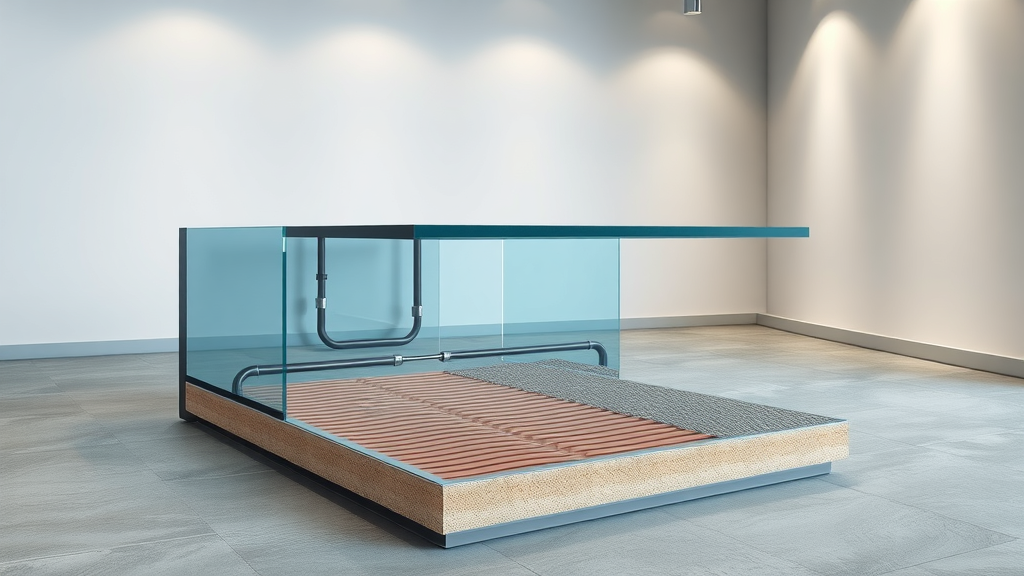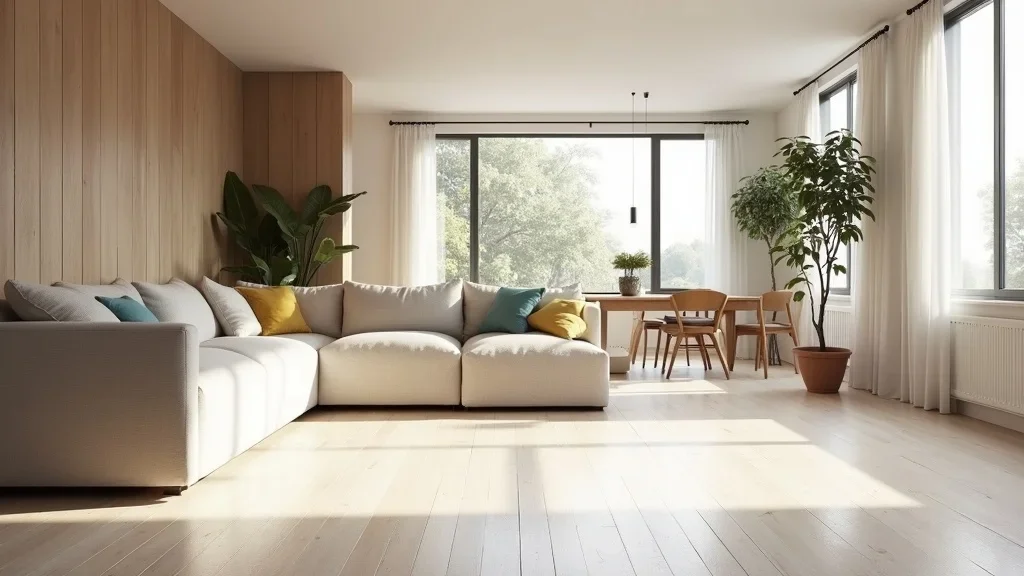Did you know that underfloor heating can reduce energy consumption by up to 30% in commercial buildings? Mastering the art of specifying commercial underfloor heating systems not only optimises comfort but also enhances energy efficiency and sustainability, making it essential knowledge for architects and M&E consultants. This comprehensive guide is your trusted resource to streamline every step in your specification process, from technical design to regulatory compliance. Let's dive into the crucial factors that can transform your next commercial space with efficient, high-performance floor heating.
Unlocking Efficiency: Why Specifying Commercial Underfloor Heating Matters
Understand the impact of underfloor heating on energy efficiency, indoor air quality, and user comfort in commercial spaces
Specifying commercial underfloor heating is no longer a niche decision—it is central to delivering energy-efficient, comfortable, and sustainable environments in modern commercial buildings. Underfloor heating systems distribute gentle, even warmth from beneath the floor, eliminating cold spots and maximising usable commercial space by removing bulky radiators. This underfloor heating system reduces energy consumption by operating at lower temperatures and integrates seamlessly with renewable energy sources such as heat pumps.
By investing in the right underfloor heating system, you improve occupant comfort with warm, draft-free environments and significantly boost the energy efficiency and long-term operational performance of commercial buildings. Air quality is noticeably improved since there is less air movement and dust circulation—crucial for offices, education environments, and healthcare facilities. These systems also unlock valuable design flexibility for architects, allowing freedom in interior planning without constraints imposed by wall-mounted heaters or complex ductwork. In short, the right floor heating solution fortifies a commercial building's credentials for sustainability, cost savings, and future-proofing.
The Business Case for Floor Heating in Modern Commercial Buildings
For architects and consultants, the business case for commercial underfloor heating is compelling. With building users and clients now demanding spaces that meet both comfort and sustainability standards, underfloor heating emerges as a critical value-add. Lower operating costs, greater design freedom, and a premium feel all dovetail to create a competitive advantage for new build and retrofit projects alike. From lobbies to boardrooms, seamless floor heat improves acoustic and thermal comfort, supporting well-being in high-traffic zones. Choosing the right system ensures energy-efficient operation, reliable heat distribution, and compliance with the ever-evolving landscape of building regulations.

Sustainability, Compliance, and Heat Distribution: Meeting Regulatory and Client Demands
As sustainability takes centre stage, specifying underfloor heating enables commercial buildings to achieve both compliance and operational excellence. Modern underfloor heating systems are engineered for compatibility with low-carbon heat sources such as heat pumps, helping reduce a building's carbon footprint and meet BREEAM or LEED sustainability standards. They also provide precise heat distribution—ensuring consistent comfort—even in large, open-plan layouts. Meeting all relevant regulations, such as BS EN 1264 and UK Building Regulations Part L, is critical to avoid legal risks and future refits. Robust documentation, commissioning, and digital controls are essential to ensure long-term client satisfaction and system performance.
When evaluating system types, it's important to understand the unique benefits and technical requirements of hydronic solutions. For a deeper dive into how hydronic underfloor heating works and its advantages in commercial settings, explore this comprehensive guide on unlocking effortless comfort with hydronic underfloor heating.
What You'll Learn in This Complete Guide to Specifying Commercial Underfloor Heating
How to evaluate heating system types and select the right underfloor heating solution
Critical specification clauses for underfloor heating systems
Key heat output, screed depth, and control system considerations
Integrating underfloor heating systems with primary heat sources and BMS
Accessing downloadable CAD details/BIM objects and NBS specification clauses
Understanding Commercial Underfloor Heating Systems
Types of Commercial Underfloor Heating: Hydronic vs. Electric Underfloor Heating
Advantages and limitations of each heating system for different commercial applications
Commercial underfloor heating generally falls into two categories: hydronic (water-based) systems and electric underfloor heating systems. Hydronic underfloor heating systems circulate warm water through pipes embedded in the floor construction, making them ideal for larger commercial spaces focused on energy efficiency, long-term cost savings, and integration with heat pumps. These systems can deliver significant heat output over extensive floor areas, making them highly suited for office blocks, hotels, schools, and retail spaces.
Electric underfloor heating employs heating cables or mats installed below the floor surface. While usually more straightforward to install—especially in refurbishment projects or smaller zones—electric systems often have higher running costs compared to hydronic options. However, they provide responsive control and are excellent for spot heating or where structural depth is limited. Both systems support a wide array of floor finishes, from polished concrete to SPC and LVT, but understanding their unique installation and operational characteristics is critical for compliance and project value.

Core Components: Heating Cables, Manifolds, Controls, and Floor Build-Ups
Every commercial underfloor heating system depends on key components such as heating cables, manifolds, and control systems to deliver safe, efficient, and precisely controllable floor heat. For electric systems, heating cables or mats are installed in continuous loops or grids, ensuring consistent heat delivery beneath the floor surface. Hydronic systems utilise water pipes connected to a manifold—a device that evenly distributes the flow from the primary heat source to various zones. Control systems are crucial; advanced digital thermostats, building management system (BMS) interfaces, and remote monitoring allow for bespoke zoning and adaptability to changing occupancy. The floor build-up—including insulation, screed depth, and surface finish—directly affects both performance and compliance with safety and efficiency standards.
For best practice, always specify high-quality insulation beneath the floor heat system to minimise heat loss downwards and focus thermal output where it's needed. System reliability hinges on correct component selection and robust commissioning—choose components compatible with the intended floor finish (timber, concrete, LVT) and lifecycle expectations of commercial environments. With these fundamentals in place, the specified heating system will deliver comfort, energy savings, and compliance from handover into long-term operation.
Comparison Table: Commercial Underfloor Heating Systems (Hydronic vs. Electric)
Feature |
Hydronic Underfloor Heating |
Electric Underfloor Heating |
|---|---|---|
Typical Installation Process |
Pipes laid in screed over insulation; manifold linking central heat source; requires skilled labour, longer install time |
Heating mats/cables installed over insulation or directly on slab; quicker install, minimal build-up height |
Heat Outputs (W/m²) |
80–120 W/m² (typical commercial spec); scalable for large areas |
100–200 W/m²; suited for smaller zones or spot heating |
Compatible Floor Finishes |
Polished concrete, tile, timber, SPC, LVT, carpet tile (with correct build-up) |
Polished concrete, tile, SPC, LVT, carpet tile (most finishes with controls, avoid thick natural timber) |
Installation Cost |
Higher upfront cost, lower running cost—best for new build or deep refurb |
Lower upfront cost, higher running cost—best for refurb, small projects |
How Commercial Underfloor Heating Works: System Walkthrough and Key Technical Features
“Correctly specified commercial underfloor heating systems create efficient, resilient buildings that outperform traditional solutions.” – Senior M&E Consultant
Key Performance Criteria for Specifying Commercial Underfloor Heating
Heat Output Calculations: Meeting W/m² Requirements

Determining and specifying the correct heat output (W/m²) is foundational to ensuring comfort, energy efficiency, and optimal heat distribution in any commercial space. Calculations must consider W/m² requirements for each space, taking into account occupancy density, fabric losses, and the type of floor heat system. Underfloor heating offers a unique advantage: it heats spaces from the ground up, reducing vertical temperature gradients and eliminating draughts commonly associated with forced-air systems.
For most commercial projects, target outputs in open-plan offices* and retail areas range from 80 to 120 W/m², while entrance lobbies or high-loss zones (like glazed atriums) may require 120 to 150 W/m². Always coordinate with the project's heat loss calculation to avoid under-specification, especially in new build or retrofit projects seeking to utilise low-temperature heat sources, such as heat pumps. It is critical to verify that the chosen system achieves both peak and average heat demands, ensuring compliance with comfort and legal standards.
* Generally valid for hydronic systems in moderately insulated commercial spaces, but typical outputs for well insulated offices are often 50 to 100 W/m², with peaks up to 150 W/m². For Electric systems, 100 to 200 W/m² is accurate but note that it's intermittent, not continuous.
Ensuring Energy Efficiency: System Integration with Heat Pumps and BMS
Energy efficiency is at the heart of modern underfloor heating specification. The best underfloor heating systems are optimised to operate at lower flow temperatures, making them ideal for integration with renewable energy technologies such as air source and ground source heat pumps. Careful system integration allows for smart load balancing, reducing energy waste and cutting running costs dramatically.
Equally important is BMS (Building Management System) integration, which enables remote monitoring, adaptive control, and scheduling. Sophisticated controls can zone heating by user demand, time of day, or building occupancy, unlocking substantial savings in office buildings, hotels, and universities. Always specify systems and components that are compatible with common BMS protocols and can accept future updates—an essential facet for future-proofing large-scale commercial heating investments.
Flow Rates, Manifold Positioning, and Distribution
The distribution of heat within commercial underfloor heating systems depends on the correct sizing of pipework (for hydronic systems), flow rates, and positioning of manifolds. Properly balanced flow rates ensure even heat delivery, preventing cold spots and minimising system stress. Manifold positions should be accessible, with space for future servicing, and centrally located to serve their respective zones efficiently.
For best practice, select manifold locations that minimise pipe lengths—conserving energy and simplifying installation. Zones should match real-world usage patterns: office wings, reception areas, meeting suites. Integrating isolation valves, pressure gauges, and remote balancing valves will streamline commissioning and ongoing maintenance, reducing total lifecycle cost for the building owner. Hydronic underfloor heating systems, when properly designed, ensure even heat distribution across large commercial spaces, delivering consistent comfort and regulatory compliance.
Floor Build-Up, Minimum Screed Depth, and Floor Finish Compatibility with Underfloor Heating
Polished concrete, timber, carpet tiles, SPC, LVT—best practices for each
The build-up of the commercial floor directly affects both performance and durability. Minimum screed depths are critical for both hydronic and electric systems—usually at least 50 mm for hydronic and as low as 10–20 mm with electric mat systems designed for overlays*. Sufficient screed acts as a thermal mass, smoothing heat output and protecting cables or pipes. Architects should check details for acoustic, fire, and movement requirements, especially in multi-tenanted or mixed-use commercial buildings.
* Note: Full embeds may need 30 to 50 mm for a thermal mass.
Each floor finish (polished concrete, timber, SPC, LVT, carpet tile) responds differently to heating. Harder finishes like concrete or tile transfer heat rapidly, making them ideal for maximising system efficiency. Resilient finishes like SPC and LVT are perfectly compatible, provided surface temps are managed to avoid deformation. Timber requires careful temperature control and selection—engineered boards perform best, while very thick hardwoods or carpets may restrict heat flow. For all finishes, use manufacturer-approved adhesives and underlays to preserve warranty and performance.
Floor Finish Type |
Minimum Screed Depth (mm) |
Max Surface Temp (°C) |
Typical Heat Output (W/m²) |
|---|---|---|---|
Polished Concrete |
50–60 |
29 |
95–120 |
Timber (Engineered) |
50+ |
27 |
70–90 |
SPC (Stone Polymer Composite) |
40–50 |
29 |
90–100 |
LVT (Luxury Vinyl Tile) |
40–50 |
27–29 |
75–90 |
Carpet Tile |
50+ |
27 |
70–85 |
Checklist: Specification Clauses to Always Include for Underfloor Heating Systems
System type (hydronic/electric)
Design heat output (W/m²) and max surface temp limits
Screed build-up and insulation specification
Control interface requirements (thermostat, BMS)
Floor finish compatibility and testing certificates
Commissioning and O&M handover deliverables
Specifying Underfloor Heating: Step-by-Step System Design for Architects & Consultants
Designing the Heating Solution for Large Commercial Spaces

Properly designing underfloor heating for large commercial spaces involves a careful blend of engineering precision and practical site knowledge. The process starts with comprehensive heat loss calculations, factoring in ceiling height, glazing areas, usage profiles, and the potential integration of renewable energy sources. Zoning designs must mirror how the space will actually be used: separate wings, individual meeting rooms, or flexible open-plan layouts.
Early coordination with structural and interior teams is essential—spacing, expansion joints in concrete floors, and screed curing times all affect the final build. Selecting insulation and confirming minimum height build-ups at the outset avoids costly redesigns. The ideal underfloor heating design also anticipates demands for rapid warm-up zones near entrances and drafty perimeters, combining consistent comfort with robust system resilience for high-traffic, high-expectation commercial environments.
Selecting the Best Heating System: Hydronic vs. Electric Underfloor Heating
When it comes to selecting the best underfloor heating system for each project, architects and consultants need to weigh factors such as upfront installation cost, projected running expenses, site constraints, and future flexibility. Hydronic systems are favored for large open areas, new build projects, and settings where running costs and energy sourcing are a top priority. Their integration with heat pumps and renewable energy delivers exceptional long-term value, especially in low-carbon commercial buildings.
Electric underfloor heating, by contrast, is popular for refits, smaller rooms, and where build-up heights are limited—like historic sites or fast-track commercial conversions. These systems excel in simplicity and speed of installation but tend to have higher operational costs, making them a better fit for low-usage zones or premium retrofit scenarios. Whichever system you select, robust specification and commissioning are central to performance and warranty continuity.
System Control and Zoning: Thermostats, BMS and Smart Controls

Precise system control and zoning are key to optimizing comfort and minimizing energy waste in commercial underfloor heating systems. For multi-tenanted buildings, hotels, or campus projects, look for networked thermostats, compatible BMS interfaces, and wireless control options. Zoning allows different areas to maintain individual set-points—for example, warmer temperatures in entrance lobbies and cooler profiles in storage or back-of-house areas.
Smart controls integrate with building management systems, giving facilities managers visibility and command over daily and seasonal programming. Modern controls allow flexible overrides, remote adjustment, and data-driven optimisation—fostering proactive maintenance and energy savings. For best results, select open-protocol components wherever possible, future-proofing your project against upgrades as BMS technology evolves and tenants change over the building lifecycle.
CAD Details, BIM Objects, and NBS Specification Clauses for Easy Project Integration
Specification efficiency increases dramatically with the right digital tools. Downloadable CAD details, BIM objects, and editable NBS specification clauses make it seamless for architects and consultants to include underfloor heating in their design and specification packs. Accurate digital assets allow for clash detection, construction coordination, and quantity scheduling—accelerating project approvals and lowering post-design surprises.
Always use manufacturer-specific content that reflects genuine system constraints, material tolerances, and maintenance zones. This ensures compliance at tender and handover stages, while supporting smooth on-site delivery with clear, coordinated design intent. For access to up-to-date downloadable assets and template specification clauses, see our resources section at the end of this guide.
“Digital integration with building management systems is as critical as thermal performance.” – Lead Architect
Video Guide: Importing Underfloor Heating CAD Details into Your Schematics
Compliance and Best Practice: Building Regulations, Standards, and Safety in Commercial Underfloor Heating Systems
BS EN 1264, UK Building Regulations Part L, and Fire Safety
Compliance forms the backbone of any successful underfloor heating specification. The benchmark standard, BS EN 1264, covers all aspects of water-based underfloor heating—including design, system testing, and commissioning. UK-specific regulations such as Building Regulations Part L set minimum energy efficiency requirements, which underfloor heating systems are uniquely designed to exceed. Fire safety—particularly regarding insulation, cable routing, and combustibility of floor finishes—must be given early and thorough consideration in the design phase.
Use only system components and assemblies that are tested and certified to current standards. Ensure all details—screed depths, insulation ratios, output limits—align with the National House Building Council (NHBC) and other regulatory bodies if applicable. Don’t overlook interfaces with fire exits, means of escape, and safety-critical areas; poor specification here can put both compliance and client reputation in jeopardy.
Specifying Floor Heating for Accessibility and Comfort Standards
Modern commercial design must address both accessibility and comfort mandates. Well-specified underfloor heating enables fully accessible, open-plan layouts—no protruding radiators, trip hazards, or complicated zoning barriers. This supports both DDA (Disability Discrimination Act) compliance and universal design principles, essential for public-facing commercial operations.
Couple this with enhanced thermal comfort by ensuring correct zoning, surface temperature limits, and fast-reacting controls. Accessibility is further supported by BMS integration—allowing for remote adjustment in multi-occupancy environments, without the need for direct intervention at each heating zone. The result: a commercial space that not only meets compliance, but delightfully exceeds user expectations.
Installation Quality: Inspection, Testing, and Hand-Over Documentation
Documentation essentials: Handover packs, O&M manuals, certification requirements
Installation quality is verified through rigorous inspection and testing at each stage of the project. Commission all zones, check for leaks or cable faults, test thermostat control and response, and confirm surface temperatures across all finishes. Assemble comprehensive handover documentation: as-built CAD drawings, operation & maintenance (O&M) manuals, certification of commissioning, and operating instructions for building managers. Clear and accurate handover packs—including compliance certificates—are now standard for professional M&E contracts and support future servicing and warranty claims.
Integrating Underfloor Heating With Primary Heat Sources: Heat Pumps, Boilers, Solar, and Multi-System Solutions
Specifying Integration with Heat Pumps and Hybrid Heating Systems

Integration with primary heat sources such as heat pumps and hybrid systems is where underfloor heating really shines. Hydronic systems are inherently built to work at low-flow temperatures (typically 35–45°C), making them the perfect partner for air source and ground source heat pumps, as well as solar thermal arrays. By operating efficiently at these lower temperatures, the building’s overall energy consumption—and carbon footprint—is significantly reduced.
Hybrid plant rooms, combining boilers for peak demand with heat pumps for base load, deliver robust reliability and allow future transition to fully renewable sources as grid supplies decarbonise. Always specify compatible control and safety components; pressure vessels, mixing valves, and expansion tanks sized correctly for the peak and part-load demands of the installation.
Controls and Monitoring: Optimising Energy Consumption and Operational Costs
Smart control options: Wired thermostats, wireless controls, BMS integration
To maximise efficiency and cut operational costs, detailed controls and monitoring must be in place from specification. Modern systems offer a mix of wired and wireless options that integrate tightly with BMS, giving facilities managers insight into consumption, temperature trends, and fault detection. From basic programmable thermostats to advanced learning algorithms, the goal is the same: deliver the required comfort at the lowest energy input.
Download Zone: CAD Details, BIM Objects, and Specification Resources for Commercial Underfloor Heating
Direct links and instructions for accessing CAD drawings, BIM content, and editable NBS specification clauses
Access all the essential digital resources to accelerate your project documentation:
CAD Drawings: Detailed floor build-ups, zone maps, and connection schematics—ideal for direct import into planning software.
BIM Objects: Preconfigured, standard-compliant BIM objects for fast Revit integration and clash checking.
NBS Specification Clauses: Download and edit certified specification language for precise, compliant documentation.
Visit: Peak Underfloor Heating’s Knowledge Base
“We adopted a comprehensive BIM object for underfloor heating—accelerating project approvals.” – Senior Project Engineer
People Also Ask: FAQs on Specifying Commercial Underfloor Heating
What is the spec for underfloor heating?
Detailed breakdown: key parameters, compliance, and system outputs
The specification covers heat output (W/m²) matched to room demands, minimum and maximum surface temperatures (typically 27–29°C for comfort), floor build-up (including insulation and screed depth), certified pipe or cable types, control system integration (thermostats, BMS), and all compliance documentation for BS EN 1264/Part L. Always require commissioning certification in your O&M package.
Is SPC or LVT better for underfloor heating?
Performance, suitability, and installation guidance for each floor finish
Both SPC (Stone Polymer Composite) and LVT (Luxury Vinyl Tile) are suitable for underfloor heating, providing the right adhesive and underlay are used, and surface temperatures are kept within manufacturer’s recommendations—usually up to 29°C. SPC has higher dimensional stability, making it ideal for large open-plan commercial areas, while LVT offers design versatility for feature zones or heavy footfall spaces. Always consult finish supplier guidance for best thermal and acoustic performance.
Are building regs required for underfloor heating?
Regulatory context, mandatory requirements, and compliance strategies
Yes—underfloor heating in commercial buildings must comply with UK Building Regulations, specifically Part L for energy conservation and Part E for acoustics. Systems must also conform to the relevant sections of BS EN 1264 and be included in the building’s fire, accessibility, and safety plans. Include compliance documentation at handover to prove regulatory conformity.
What are the best settings for underfloor heating?
Optimal temperature ranges, programming, and efficiency tips
For best comfort and efficiency, set underfloor heating systems for surface temperatures no higher than 27–29°C in occupied zones*. Use programmable or BMS-linked thermostats for scheduling and zoning. In offices and classrooms, target 19–21°C ambient temperature with setback overnight. Regularly review usage patterns to update schedules and optimise energy use.
* Note: 27° C for wood/vinyl (to prevent warping) versus 29° C for tiles/concrete.
Troubleshooting and Value Engineering: Common Specification Pitfalls in Commercial Underfloor Heating
Avoiding Over-Specification and Under-Specification
The most common pitfalls come from either underestimating the heating load (leading to cold spots or system failures) or specifying excessive system outputs (wasting energy and breaching surface temperature limits). Always use independent heat loss calculations to match system design. Double-check compatibility of specified components to avoid warranty disputes later on. Don’t default to the highest output “just in case”—get the data right up front.
Dealing with Complex Commercial Space Constraints
When working in intricate floor plans or retrofits, flexibility is key. Tackle irregular zones or height restrictions by considering electric systems, low-profile panels, or adapting pipe routing around fixed obstructions. In multi-use spaces or heritage conversions, engage in early collaboration with all trades to resolve build-up, installation sequence, and future servicing right from the start. This proactive approach avoids clashes and expensive on-site changes.
Maintenance, Accessibility, and Future-Proofing Your Heating System
Long-term performance hinges on easy access to key components—such as manifolds and control panels—robust documentation for future maintenance teams, and the ability to upgrade controls or expand zones. Use open-protocol controls and specify accessible service panels. Pre-plan for technology upgrades, evolving building usage, and ease of repair. This ensures operational resilience for the full commercial lifecycle.
Top five specification mistakes—and how to fix them:
Omitting compatibility checks for new finishes or overlays — always confirm with the manufacturer.
Ignoring room-by-room heat loss — commission a detailed survey, even for refurbishments.
Forgetting BMS/BACnet integration — specify open interface protocols and upgradable thermostats.
Under-specifying insulation — use the highest practical grade under and around system zones.
Poor documentation packs — insist on “as built” CAD files, commissioning, and warranty certificates as handover deliverables.
Key Takeaways for Architects & Consultants on Specifying Commercial Underfloor Heating
Always start with robust heat demand calculations for each commercial space
Select a tailored hydronic or electric system for each project context
Specify correct screed depth and floor finish compatibility
Coordinate control strategies—zoning, BMS, and seasonal programming
Mandate compliance with BS EN 1264 and Building Regulations Part L
Use manufacturer-provided CAD, BIM, and NBS templates to ensure accuracy
Hand over full documentation packs—commissioning certificates, as-built drawings, O&M manuals
Frequently Asked Questions on Specifying Commercial Underfloor Heating Systems
Can underfloor heating be retrofitted in existing commercial spaces?
Yes—low-profile electric or hydronic panels can be installed over existing substrates, but always check floor buildup and insulation.Do underfloor heating systems require annual servicing for warranty compliance?
Yes—hydronic systems in particular require periodic inspection, pressure checks, and flushing to maintain performance and warranties.Which control systems offer the best integration with BMS?
Look for systems with open BACnet/IP, Modbus or KNX compatibility. Latest digital thermostats allow plug-and-play BMS integration.How do I select the right manifold and zoning approach?
Base zones on real room usage and accessibility, size pipework and balancing valves for equal flow, and allocate isolated loops for future flexibility.
Next Steps: Get Expert Support with Your Commercial Underfloor Heating Specification
Industry-specific advice, tailored heat loss calculations, and free project consultations
For expert help or advice visit Peak Underfloor Heating at https://peakunderfloorheating.com/
Conclusion: Mastering the specification of commercial underfloor heating means: better comfort, operational efficiency, and regulatory compliance—making your building projects future-ready.
If you’re looking to take your commercial heating strategy even further, consider how integrating renewable energy sources can amplify both efficiency and sustainability. Our in-depth article on renewable energy heating hacks for lower carbon buildings explores advanced solutions and practical tips for reducing carbon footprints in modern developments. By combining underfloor heating with innovative renewable technologies, you can unlock new levels of performance and future-proof your projects against evolving environmental standards. Discover how these strategies can help you deliver truly next-generation commercial spaces that stand out for both comfort and eco-responsibility.
When specifying commercial underfloor heating, it’s crucial to understand the differences between hydronic and electric systems. Hydronic systems circulate warm water through pipes embedded in the floor, making them ideal for larger spaces due to their energy efficiency and compatibility with renewable energy sources. Electric systems, on the other hand, use heating cables or mats and are often preferred for smaller areas or retrofit projects because of their ease of installation. For a detailed comparison of these systems, including their advantages and limitations, refer to the article “Wet and electric underfloor heating in commercial environments” by Steven Rooney. (prnewslink.net)
Additionally, integrating underfloor heating with various floor finishes requires careful consideration. Junckers provides comprehensive guidance on installing their solid hardwood floors over underfloor heating systems, ensuring optimal performance and longevity. Their resource, “Underfloor Heating, Clip system, Commercial & residential E 4.1,” offers valuable insights into best practices for such installations. (junckershardwood.com)
By consulting these resources, architects and M&E consultants can make informed decisions that enhance comfort, energy efficiency, and design flexibility in commercial spaces.
 Add Row
Add Row  Add
Add 









Write A Comment